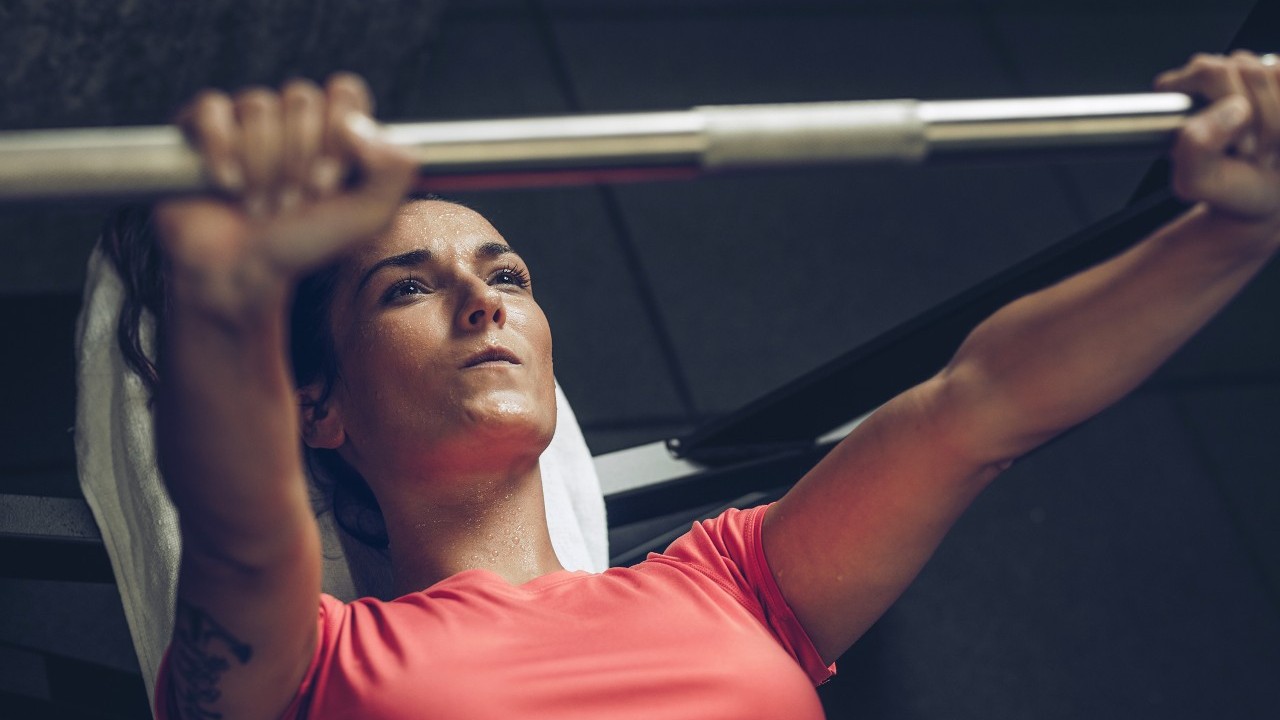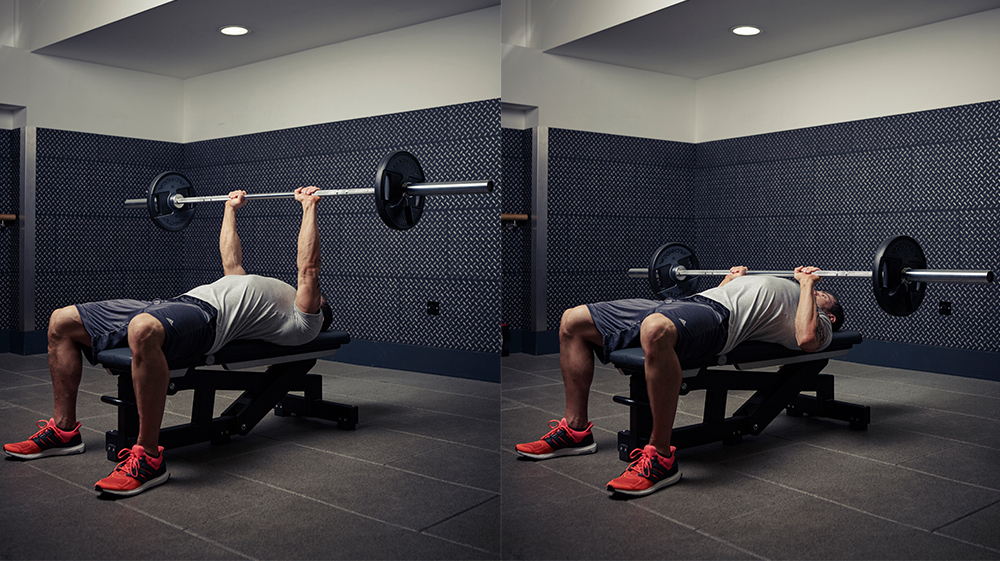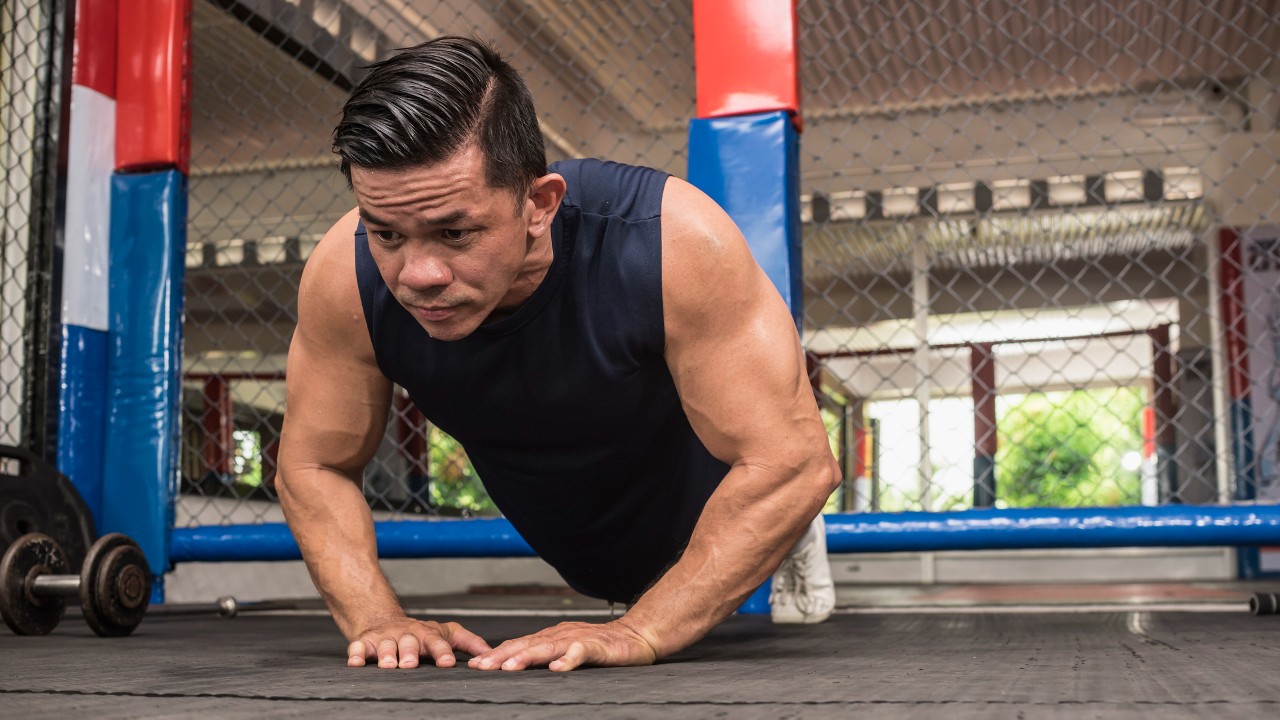How To Do The Close-Grip Bench Press
Bring your hands close together to transfer the emphasis from your chest to your triceps

The bench press deserves its place in the pantheon of barbell exercises – it’s a belter of an exercise for building chest and shoulder strength – but its exalted status shouldn’t make you afraid to deviate from tradition. The dumbbell bench press is preferred by many to build muscle in your chest, but if you want to add size to your arms, the first variation you should try is the close-grip bench press.
As the name suggests, this alternative involves moving your hands closer together on the bar. The standard bench press works your chest, shoulders and triceps, with the chest muscles doing the bulk of the work, whereas the close-grip bench press moves the focus to the triceps. Rest assured your chest and shoulders will remain involved, but the spotlight is on the backs of your upper arms – in fact, this move is one of the best triceps exercises.
To help you understand the ins and outs of the move, we enlisted NSCA-accredited strength and conditioning coach Andrew Reay, who spoke to us on behalf of sports coach booking platform Sport Session.
Benefits Of The Close-Grip Bench Press
The close-grip bench press is a worthy addition to your workout programme on account of its muscle-building benefits, strength-boosting qualities and the performance-related carry-over to other activities.
“It requires more work from the arms, and the triceps specifically,” says Reay. “So if you want good ‘T-shirt arms’, this is a good exercise for you.”
Does the close-grip bench press still work the chest?
Yes. A review published in the Strength And Conditioning Journal stated that, while engagement of the triceps is the focus of the movement, the “pectoralis major is still highly active in the close-grip bench press”. As a result, “if the loading, sets, and repetition ranges are appropriate, regular use of the close-grip bench press should contribute to hypertrophy of those muscles”.
Another advantage listed by the Strength And Conditioning Journal article is the ability to use the close-grip bench press as an alternative to the traditional bench press for those who find a wider grip on the bar uncomfortable. A wider grip can place more stress on the shoulder joints because of the shoulder horizontal abduction that occurs during the lowering of the bar, it says. A narrower grip can reduce stress on the shoulders, while still providing a hypertrophic stimulus to the chest.
But more muscle isn’t the only positive impact this exercise can have. It can also be used to develop strength that will improve performance in other sports.
The same review found the muscles used during the movement matched those needed for a chest pass. As a result, “the close-grip bench press could be used to develop the strength foundation needed for the upper-body power demands of court sports such as basketball and netball”. This strength is also useful in contact sports like rugby and American football.
Get the Coach Newsletter
Sign up for workout ideas, training advice, reviews of the latest gear and more.
How To Do The Close-Grip Bench Press

Lie on a flat bench with the bar above your head. “Make sure your head is close to the bar,” says Reay. “If it’s too far behind your head then unracking it will be a limiting factor.”
“Grip the bar so your hands are just slightly outside of the shoulders. If they are too close together, the movement will feel clunky,” says Reay. This will also cause your elbows to flare out to the side, rather than remaining tucked in to your sides, and will also make it difficult to keep the bar balanced.
“With the standard bench press, your upper arm should form a roughly 45° angle with your torso,” says Reay. “For the close-grip bench press they should be tucked a bit tighter to the body – this will take some pressure off the chest and put more emphasis on the triceps.”
When your set-up is sorted, take a deep breath and brace your body, then unrack the bar and retract your shoulder blades. Lower the bar towards your body in a controlled manner until it touches your chest in line with your nipples, then, keeping your elbows tucked in to your sides, push the bar back to the starting position.
Make sure your feet are firmly planted throughout, and push down through the floor during the upwards (or concentric) phase of the movement.
This is an exercise that should be done with a spotter handy, especially if you’re new to the move, but if you are flying solo make sure you use a considerably lighter weight.
Common Beginner Close-Grip Bench Press Mistakes
The close-grip bench press promises plenty of training benefits to anyone including it in their push day plans but, as with any resistance exercise, this is largely dependent on you performing it correctly. We’ve compiled a list of the most common close-grip bench press mistakes to help you plot a pitfall-free course to bigger arms.
Weight: The close-grip bench press switches emphasis from the chest to the triceps. As this is a smaller muscle, you’ll have to leave your ego at the door and drop the weight. “Of the bench variations, your standard bench press is going to be your heaviest lift,” says Reay. “Then your close-grip and incline bench press will be similar to each other, and lighter than the flat bench.”
Elbows: “A lot of the time, you’ll see a beginner’s elbows flaring out,” says Reay. This takes pressure off the triceps and places undue stress on your shoulders, increasing your risk of injury. “Ideally, you should keep your elbows tucked in to your sides.”
Bar path: Another common mistake Reay says he sees in gyms is people lowering the bar to the wrong position. “The bar often touches either too high or too low on the chest,” he says. “When people use the narrower grip, they sometimes bring the bar down lower on the body and then find themselves stuck in the bottom of the lift.” Instead, lower the bar to the same point as you do for a bench press: the lower sternum, or roughly in line with your nipples.
Brace your body: While the triceps are the star of the show during this movement, Reay says bench press variations should be treated as full-body exercises. “The whole body can be used: retract your shoulder blades, brace your core and keep your feet flat on the floor,” he says. “Put a little bit of pressure through your feet to anchor your body so you can generate more force through the bar.”
Close-Grip Bench Press Variations
Close-grip dumbbell press
If you want to make sure one of your arms isn’t getting a free ride, train each arm individually by using dumbbells instead of a barbell. This will balance out the strength in your body and ensure one side of it isn’t doing more of the work. Lying on a bench, hold a pair of dumbbells together just above your chest with your palms facing each other. Press the weights overhead, making sure you don’t let them move too far apart, then bring them back down to your chest slowly.
Diamond press-up

If the standard press-up is a good bodyweight alternative to the standard bench press, moving your hands closer together under your body creates a press-up variation that more closely mimics the close-grip bench press – and achieves the same effect by targeting the same muscles.
To perform a diamond press-up, get into a press-up position with your hands directly under your chest, positioned so the thumbs and index fingers of each hand touch to form the outline of a diamond. Bend your elbows to lower your chest to the floor, ensuring that you don’t flare your elbows out too much. Pause at the bottom of the move, then push powerfully back up to the top position. The diamond press-up shifts the emphasis of the exercise from your chest to your triceps, making it a great assistance move if you’re struggling with the close-grip bench press.

Harry covers news, reviews and features for Coach, Fit&Well and Live Science. With over a decade of training experience, he has tried everything from powerlifting to gymnastics, cardio to CrossFit, all in a bid to find fun ways of building a healthy, functional body.
- Nick Harris-FrySenior writer









